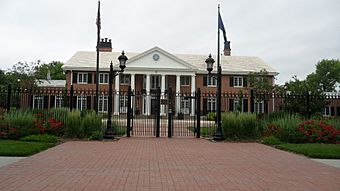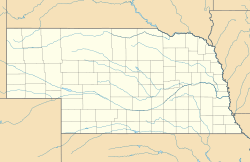Nebraska Governor's Mansion facts for kids
Quick facts for kids |
|
|
Nebraska Governor's Mansion
|
|
 |
|
| Location | 1425 H St., Lincoln, Nebraska |
|---|---|
| Built | 1957 |
| Architect | Solheim, Selmer A.; Broer, W.J., Construction Co. |
| Architectural style | Classical Revival |
| NRHP reference No. | 08000173 |
| Added to NRHP | March 12, 2008 |
The Nebraska Governor's Mansion is the official home for the governor of Nebraska and their family. It is located in Lincoln, Nebraska. This special house is built in a Georgian Colonial style. It first opened as the governor's residence on March 17, 1958.
Contents
About the Governor's Mansion
What the Mansion Looks Like
The Nebraska Governor's Mansion covers an entire city block. This shows how important the building and the governor's job are. The area around the mansion has big lawns, pretty gardens, and walking paths. There is also a fountain. A strong iron fence was added around the property in the late 1990s.
The main entrance is on the north side of the house. It has six white Doric columns that hold up a two-story triangle-shaped roof called a pediment. This roof has small block-like decorations called dentils. There is also a round window high up. The large front door has twelve panels. It is surrounded by narrow windows on the sides (sidelights) and a window above (transom window). All these windows have a criss-cross pattern. The doorknob on the main door is very old. It came from the first governor's mansion, which was taken down in the 1950s.
The rectangular brick building has decorative shutters on all its windows. Each window also has a flat arch above it called a jack arch lintel. On the west side of the building, there is a one-story garage for three cars. Its flat roof acts as a porch for the guestrooms on the second floor. A sunroom was added to the east side of the building. This helps balance the look of the house with the garage on the other side. This sunroom also has a porch. Windows on the east and west sides are arranged differently. They focus more on privacy and comfort inside the home. For example, bathrooms have single windows instead of double ones.
History of the Governor's Home
The First Governor's Mansion (1899-1955)
The first Nebraska Governor's Mansion was a large private home. It was built in 1890 for a person named D. E. Thompson. In 1899, the state of Nebraska bought this house and its furniture from Thompson. They paid $21,385 for it.
However, by the mid-1900s, the old mansion was not working well for the governor. It was getting old, and its layout was not good for official events. Parts of the building were even unsafe, according to the fire department. The family's private areas felt too big, while the public reception areas were too small.
From 1945 to 1953, Nebraska lawmakers talked about what to do. They thought about buying a different building or accepting a donated home. In 1953, they decided that building a new house would be cheaper than fixing up the old one. So, in 1955, the Nebraska legislature set aside $200,000. This money was for buying land around the old mansion and building a brand new one.
Designing the Current Mansion
The governor at that time, Victor E. Anderson, was very involved in planning the new mansion. He wanted to make sure people knew he wasn't just spending public money for himself. Governor Anderson asked for the building plans of the Florida Governor's Mansion. He also visited the Arkansas Governor's Mansion to get ideas.
He also asked the wives of past Nebraska governors for their thoughts. Mrs. Elizabeth Peterson, whose husband Val Peterson was a former governor, had a great idea. She suggested that the first floor of the new mansion should be only for official and public events. The governor's family would live separately on the second floor. This idea was used in the final design of the current building.
Three important local architects also helped. They were Frank Latenser, Edward J. Sessinghaus, and Professor Linus Burr Smith. They formed a committee to study the project. Their job was to choose an architect for the new mansion. In January 1956, the State Building Commission chose Selmer A. Solheim, an architect from Lincoln, to design the building.
Solheim first planned for the mansion to be made of Indiana Limestone. He wanted it to match the nearby State Capitol Building. However, the Building Commission said no because of the high cost. They decided the new mansion would be made of cheaper, locally found red brick instead.
Before the old mansion was torn down, Solheim chose some furniture to use in the new building. About 300 other items were sold to the public. This raised an extra $2,416 for the new mansion's construction.
The plans for the new mansion were shared in August 1956. People immediately had strong opinions about them. Solheim called his design "Modified Georgian Revival." He chose this style to honor a traditional American way of building. Solheim was known for modern designs. But he explained that modern styles "might appear quite dated 25 to 30 years from now."
Some local architects did not like the plans. Harry F. Cunningham, who had worked on the State Capitol, was one of them. He wrote that the new mansion would look like a "lost stray cat" next to the "distinguished Capitol." He especially disliked the "pink brick" next to the "warm gray stone of the Capitol." Cunningham blamed the State Building Commission for this. He felt they didn't know enough about building or have good taste. He thought Solheim's design was fine for another place, but not next to the Capitol.
However, other important local architects defended the design. Frank Latenser, who helped choose Solheim, was one of them. Cunningham tried to get the American Institute of Architects to ask Governor Anderson to make Solheim redesign the building. But Latenser and others convinced the AIA not to. They also talked to Cunningham, who then said he was "quite ready to call off the war."
Construction finished, and the mansion opened for public tours in March 1958. About 35,000 people from all over Nebraska visited the mansion in the first two days. On opening day, Solheim wrote a poem. It honored the building, the workers, and the taxpayers who supported the project.
"All have a share in the beauty,
All have a part in the plan
What does it matter what duty
Falls to the lot of man?
Someone has blended the plaster
And someone has carried the stone:
Neither the man nor the master
Ever has builded alone.
Making a roof from the weather,
Or building a house for the king,
Only by working together
Have men accomplished a thing."
Renovating the Mansion
Bill Orr, who was the husband of Governor Kay Orr, helped update the mansion in the late 1980s. He moved into the mansion with his wife in 1987. He thought the inside looked like "early Holiday Inn" and believed they could do better.
Bill Orr wrote a cookbook called The First Gentleman's Cookbook. All the money from the book went to a $200,000 fund. This fund was used to fix up and redecorate the mansion. Orr's cookbook included recipes from famous people like Barbara Bush, Nancy Reagan, Warren Buffett, Johnny Carson, Katharine Hepburn, Tom Osborne, and Dick Cavett.



